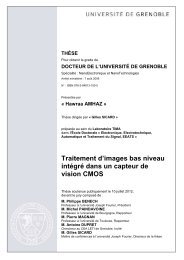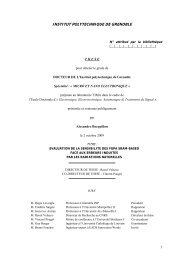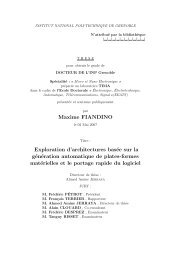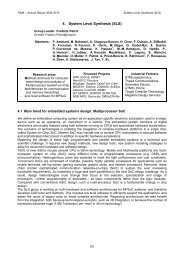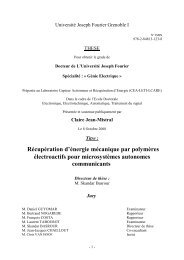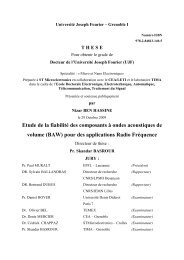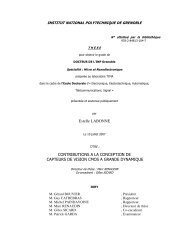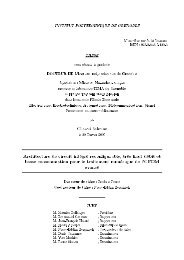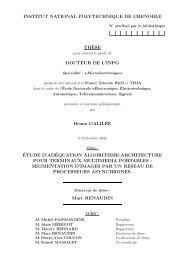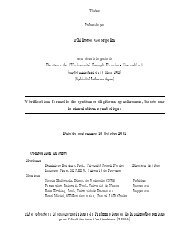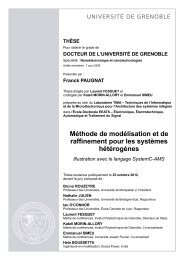Defect oriented testing in advanced CMOS
Defect oriented testing in advanced CMOS
Defect oriented testing in advanced CMOS
Create successful ePaper yourself
Turn your PDF publications into a flip-book with our unique Google optimized e-Paper software.
<strong>Defect</strong> Oriented Test<strong>in</strong>gVictor ChampacNational Institute for Astrophysics,Optics and Electronics-Mexicochampac@<strong>in</strong>aoep.mx
National Institute for Astrophysics,Optics and ElectronicsNational Council for Science and TechnologyCONACY-MexicoLocated <strong>in</strong> Puebla, MexicoOriented to research and post-graduate programs
Design and test group,research areas <strong>Defect</strong> model<strong>in</strong>g Development of new test strategies Signal <strong>in</strong>tegrity: model<strong>in</strong>g and verification Noise tolerant circuit design Process tolerant circuit design
Outl<strong>in</strong>e Introduction Interconnection opens defects modell<strong>in</strong>g Detectability of <strong>in</strong>terconnection opens A test framework for <strong>in</strong>terconnection opens Conclusions
Motivation of the Work• Opens can appear due to the high number ofvias/contacts.• New technologies as cupper makes opens more likelyto occur.• Some opens are difficult to detect.• Special <strong>test<strong>in</strong>g</strong> conditions are required to test opens.• Opens are responsable of test scapes.
Test<strong>in</strong>g schemeTestvectorsCircuit undertestobservationcomparisonAccept/rejectAutomatic test equipmentreference
Quality levelAccepted chips<strong>Defect</strong>-freechipsManufacturedpartsTest<strong>in</strong>g<strong>Defect</strong>ivechipsRejectedchips
Open <strong>Defect</strong>s
Interconnection opens
<strong>Defect</strong> Modell<strong>in</strong>g
Experimental measurementsIDDVDSVM
Experimental measurements1:CV = 3.8fF __ C 23.8fFGNDV=2 : C 3.8fF __ C 3.8fFDDV=GNDV=DD3:C = 23.8fF __ CGNDVDDV=3.8fF
Topology dependenceViVci..VcnVifFault00[V DD -|V TP |, V DD ]SA-101[V DD -|V TP |, V DD ]SA-110[0, V TN ]SA-011[0, V TN ]SA-0 Full controllability Partial controllability Low controllability
Partial controllabilityOne of the best test conditions can not be generatedV i V c = 00, 01, 11 okV i V c = 10not ok
Low controllabilityThe most favorable vector conditions can not be generatedV i V c = 00, 11 okV i V c =01, 10 not ok
Test framework for<strong>in</strong>terconnection opens
GEVEOPFASOPCoverageok?Test setvectors
Problem Def<strong>in</strong>ition000Input0SA-0coupl<strong>in</strong>gl<strong>in</strong>es 0For favour<strong>in</strong>g detection with a stuck-at 0 vector(Vif < VTN), the coupl<strong>in</strong>g signals should be at 1 logic
Problem Def<strong>in</strong>ition111Input1SA-1coupl<strong>in</strong>gl<strong>in</strong>es 1For favour<strong>in</strong>g detection with a stuck-at 1 vector(Vif >VDD-|VTP|), the coupl<strong>in</strong>g signals should be at 1 logic
CircuitDescription(Verilog)Input FilesRelation ofcoupl<strong>in</strong>gsEquivalence ofNodesOPVEGOPVEGStep 1Order<strong>in</strong>g and format of netlistIdentify coupl<strong>in</strong>gs to VDD,GND and between nodesStep 2Coupl<strong>in</strong>gFactorIdentification and Selection ofcritical coupl<strong>in</strong>gs betweennodes victim and aggressorsStep 3Obta<strong>in</strong> favorable testpatterns consider<strong>in</strong>g coupl<strong>in</strong>gsignals
Candidated l<strong>in</strong>es A l<strong>in</strong>e is selected as critical when the ratio of thecoupled capacitance to the to total capacitance ishigher than a certa<strong>in</strong> coupl<strong>in</strong>g factor.CcCT> Coupl<strong>in</strong>g Factor
OPVEG MetricsGenerated Vectors: They are those vectors for which atest vector was generated at least for one constra<strong>in</strong>t(SA-0 or SA-1 ).Vectors 100% Ok: They are those vectors thatobta<strong>in</strong>ed the proper logic level for all the coupledsignals.
ResultsCoupl<strong>in</strong>gFactor20 %60 %100 %CriticalFaults3208832GeneratedVectors2987327Total Faults = 364CompactedVectors2267127Vectors100 % OK2296724C432OPVEGEffectiveness82.8 %79.9 %79.7 %Coupl<strong>in</strong>gFactor20 %60 %100 %CriticalFaults41815848GeneratedVectors38813738Total Faults = 486CompactedVectors2407223Vectors100 % OK31112937C499OPVEGEffectiveness85.5 %83.2 %78.1 %Coupl<strong>in</strong>gFactor20 %60 %100 %CriticalFaults42810420GeneratedVectors4219517Total Faults = 578CompactedVectors3268217Vectors100 % OK3869217C1908OPVEGEffectiveness92.5 %89.9 %85.0 %Coupl<strong>in</strong>gFactor20 %60 %100 %CriticalFaults1454408206GeneratedVectors1318373197Total Faults = 2204CompactedVectors1067310155Vectors100 % OK1130355187C2670OPVEGEffectiveness85.2 %89.6 %93.3 %
C432Coupl<strong>in</strong>gFactor20 %100 %Time ofselection ofNodes (m:s)00:4100:46CPUUsage47 %42 %Time ofATPGStuck-at-0 (m:s)15:4200:36CPUUsage93 %94 %Time ofATPGStuck-at-1 (m:s)10:5100:30CPUUsage95 %94 %ResultsC499Coupl<strong>in</strong>gFactorTime ofselection ofNodes (m:s)CPUUsageTime ofATPGStuck-at-0 (m:s)CPUUsageTime ofATPGStuck-at-1 (m:s)CPUUsage20 %100 %01:4101:2541 %50 %22:3200:5195 %89 %16:5100:4589 %89 %C1908Coupl<strong>in</strong>gFactor20 %100 %Time ofselection ofNodes (m:s)03:1203:00CPUUsage41 %43 %Time ofATPGStuck-at-0 (m:s)11:2800:19CPUUsage93 %86 %Time ofATPGStuck-at-1 (m:s)11:1400:20CPUUsage94 %91 %C2670Coupl<strong>in</strong>gFactor20 %100 %Time ofselection ofNodes (m:s)43:4052:48CPUUsage48 %34 %Time ofATPGStuck-at-0 (m:s)49:1704:22CPUUsage94 %94 %Time ofATPGStuck-at-1 (m:s)46:0404:08CPUUsage94 %93 %
Effectiveness us<strong>in</strong>gconventional ATPG
Identification of criticalcasesNon observable CaseThis case appears when it is not possible to propagate the fault-effectfor favourable test at the coupl<strong>in</strong>g l<strong>in</strong>es.Non Controllable CaseThis case appears when it is not possible simultaneously to sensitizethe fault and to have favourable conditions at the coupl<strong>in</strong>g signals.
Non observable caseX10X20EbC0XEC0g0/1C0XEC0X11X12EbC1X21X22EbC2XEC1gXEC2gSA0C20/1.XEC1XEC2PCgatePC1 / 0..X18X28EbC8XEC8g0 / 1XEC8
Non controllable caseX15XEB[0:4]B5E5Eb5EbB5EbB5g1 0 10SA0XEB5XEB5gXEB[6:8]1PBgatePBC0X25
DFT techniques• Increases separation between l<strong>in</strong>es• Place critical coupl<strong>in</strong>g l<strong>in</strong>es at different metal levels• Insert grounded l<strong>in</strong>es
ConclusionsInterconnection opens have been modelled and analyzedA test framework for <strong>in</strong>terconnection opens has beendeveloped.GEVEOP attempts to generate the most favourable testvector conditions by apply<strong>in</strong>g proper logic levels at thecoupled signalsThe number of considered critical open defective l<strong>in</strong>es can bem<strong>in</strong>imized by select<strong>in</strong>g only those l<strong>in</strong>es with significantcoupl<strong>in</strong>g.FASOP is under development, it evaluates the defect coverageof <strong>in</strong>terconnection opens




